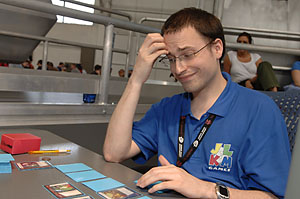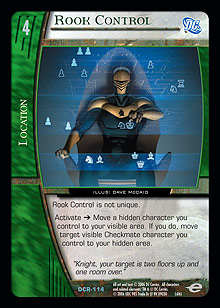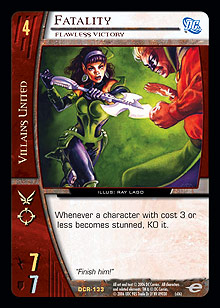Almost two years after my Pro Circuit debut, I’d done a very good job of not getting noticed. Having some well-known teammates had helped, as they would get the early feature matches while I kept a low profile with the same deck. But you can’t shine if you stay in the shadows forever; the next round was to be my first in the feature match area that players affectionately refer to as “the cage” because of the metal spectators’ balcony.
 My first cage match was to be against Alex Etzel with a G’Lock variant that looked to win by paying 25 endurance to Captain Marvel, Champion of Magic, and it was going to be about as close as my last match against G’Lock. Even Tim Willoughby would struggle to make this match sound interesting, as I missed Ahmed Samsarra and Alex took a very firm grip on the game.
My first cage match was to be against Alex Etzel with a G’Lock variant that looked to win by paying 25 endurance to Captain Marvel, Champion of Magic, and it was going to be about as close as my last match against G’Lock. Even Tim Willoughby would struggle to make this match sound interesting, as I missed Ahmed Samsarra and Alex took a very firm grip on the game.
With eleven ways to get Samsarra into play (after which you can search for a character each turn), Deep Green was one of the more consistent decks around—but that’s only enough to get the King into play 90% of the time. The TAWC build sacrificed a little power to have an extra five ways to get Samsarra, and even that would fail 3% of the time.
I’d had the one deck implosion I was due for the day and only needed to win half my remaining games for a very credible 7-3 record. Things were looking good (as long as I could stay out of the cage).
Round 7 I got paired down and faced Pat McCavana with a new Squadron build that ran the Fate Artifacts instead of the traditional combat tricks. That gave him some permanent size increases but made it very difficult to counter defensive tricks.
Turn 3, I had the initiative and was facing a board of three characters. Thanks to Mikado and Mosha, I was able to stun all of them, but the turn was still not over. Wanting to keep two guys around and search for his 4-drop, Pat played the last two cards in his hand—Answer the Call and Panacea Potion. The two effects are so powerful that they had to be given a drawback; they only succeed if you’ve got no cards in hand when they resolve. The one card in my deck that could do something about that—Slaughter Swamp—happened to be in my row, and I used it to return a single card to Pat’s hand, wrecking both the cards he’d played.
Things got even worse for Pat on turn 4 as I played Metallo, John Corben, the nemesis of Fate Artifact decks. Lady Lark tried to take him down, but a team-up and Knightmare Scenario took care of that. Pat had little choice but to attack Melissa Gold with her two Fate Artifacts into Metallo, and the Artifacts went away along with Pat’s chances.
I could easily have had a Tommy Ashton experience that round. Everything Pat had done had been countered, and it felt more like a demonstration game than a competitive match. It was Pat who turned the game into a positive experience; he was the nicest guy I met all weekend and was genuinely appreciative of the level of understanding it took to shut him down so easily. Pat was one of only three people I played who finished outside of the money, but with his positive attitude to life, he is the richest of all.
Round 8 wasn’t going to be quite so easy. Eric Hunter had done well with even initiatives and chose it again. One of his Your Move Games teammates was playing a variant on Deep Green, so he understood how my deck worked.
 This was my third match against Good Guys, but I’d had evens the last two times, and that makes a big difference. My best chance would be to use Rook Control on Merlyn, Deadly Archer, moving him to the concealed area so that he could keep his cosmic counter and snipe away. I hadn’t tested the plan for this matchup, but it had worked well against traditional Squadron decks.
This was my third match against Good Guys, but I’d had evens the last two times, and that makes a big difference. My best chance would be to use Rook Control on Merlyn, Deadly Archer, moving him to the concealed area so that he could keep his cosmic counter and snipe away. I hadn’t tested the plan for this matchup, but it had worked well against traditional Squadron decks.
Everything was going to plan until turn 3, when Eric played No Man Escapes the Manhunters to try to make Samsarra visible. If he succeeded, then I’d have no concealed character to exchange with Merlyn. Fortunately, I had Huntress, Reluctant Queen in hand and was able to negate the trick.
Eric then let me play Rook Control and used a second No Man Escapes the Manhunters to try to bring Merlyn out of hiding. Tom Reeves has always insisted that Deep Green needs two copies of Huntress, and after something similar came up in testing, I had to agree. I searched out the second copy, and Merlyn stayed where he was.
The discards pretty much devastated my hand, and I played the rest of the game from the top of my deck and from what Samsarra could fetch—but it was good enough, and I hit 7-1.
Round 9, and I was back in the cage for a match that deserves to be remembered for yet another innovative deck from the Australians who inhabit VSParadise. Scott Hunstad was piloting one of the very few Villains United decks in the tournament, and his results showed that they’d seen something in the team that the rest of us missed.
Turn 3 I had to make what is very often the most important decision of the game: do I make Samsarra visible, where he’s rather vulnerable, or do I make him concealed and take the endurance hit from being attacked directly? Scott had Dr. Psycho, Mental Giant and Dr. Polaris in play, so I figured he was playing some kind of control/burn deck. If so, Deathstroke the Terminator, Lethal Weapon was likely to show up the following turn, and the correct play was to make Samsarra visible rather than risk losing the damage race.
 At this point I’d like to remind you that it’d been a very long day (the discard deck mirror matches were going well past the 30-minute mark), and I was suffering from jet lag. The thought that a Villains United deck might make Fatality, Flawless Victory on turn 4 hadn’t entered my head.
At this point I’d like to remind you that it’d been a very long day (the discard deck mirror matches were going well past the 30-minute mark), and I was suffering from jet lag. The thought that a Villains United deck might make Fatality, Flawless Victory on turn 4 hadn’t entered my head.
The game still wasn’t lost when Scott played Fatality. If I was able to stun her and fetch a team-up with Samsarra, then I’d be able to fetch Science Spire the following turn, and Samsarra could escape. I don’t remember whether Scott foiled my chances of doing this or whether I messed up, but Samsarra ended up attacking.
Turn 5 I had to find a way to avoid Samsarra getting stunned, as I had nothing to stop Fatality KO’ing him. I went through every scenario and came up with only one way: if I re-recruited Samsarra in the concealed area, then the visible one would go away (because of the uniqueness rule), and the concealed one would be safe from attack.
Even after I made the play, I didn’t see anything wrong with it. Scott just sat there and looked at Dave Humpherys, who picked the Samsarra out of my KO’d pile and read him. Eventually it dawned on me what I’d done. Samsarra had hit the KO’d pile from play. I’d just hit the suicide button, in the feature match area to boot. This would go down as the worst play in the Pro Circuit, ever.
Another can of cola and some orange slices (from the player’s lounge) weren’t going to be enough to pick me back up. Fatigue had set in, and I was hoping for a nice simple match round 10, one where the deck would play itself.
That wasn’t going to be. Round 10 was Dan Clark with what at first sight looked like a fairly standard Injustice Gang burn deck. With no Doom in the format, he would presumably be making The Joker, Headline Stealer on turn 4. I assumed that deck would be a breeze for a deck that runs so few plot twists.
Turn 3 I figured endurance was more important than protecting Samsarra. Injustice Gang generally runs Death Trap—which returns characters to hand rather than KO’ing them—and nobody would run the new Injustice Gang Satellite without a way to search for it.
The main problem with my reasoning is that if Dan Clark had been running the kind of build I thought he was, there was no way (however well he played) that he was going to be at 7-2. Turn 4 he brought out Poison Ivy, Deadly Rose and another 2-cost character, teamed-up with Lex Luthor for a second Revenge Squad character, and played Mr. Mxyzptlk, Fifth Dimension Imp for free. A KO to Poison Ivy and an All Too Easy later, and Samsarra was in my KO’d pile for the second game running. I finished the day on 7-3.
Ian “Half Asleep by Nine” Vincent